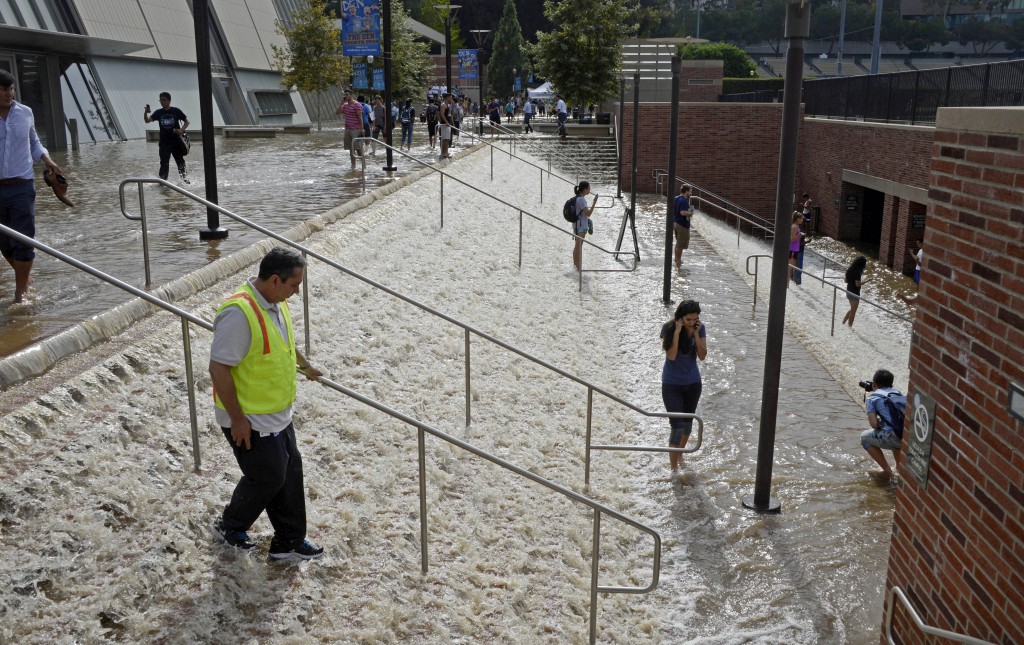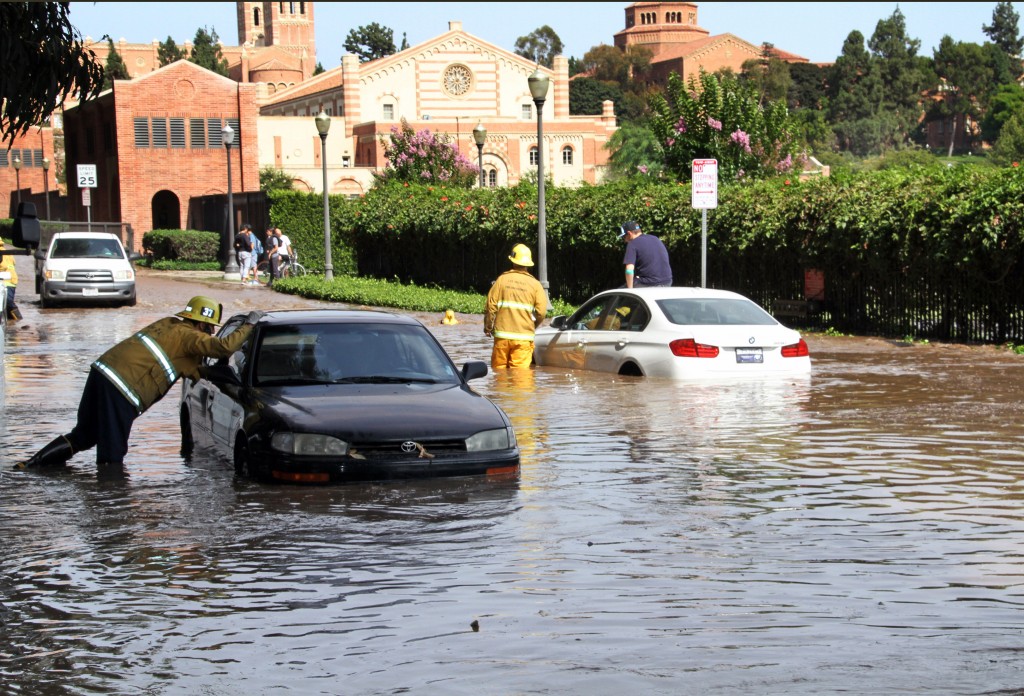- California Assembly OKs highest minimum wage in nation
- S. Korea unveils first graphic cigarette warnings
- US joins with South Korea, Japan in bid to deter North Korea
- LPGA golfer Chun In-gee finally back in action
- S. Korea won’t be top seed in final World Cup qualification round
- US men’s soccer misses 2nd straight Olympics
- US back on track in qualifying with 4-0 win over Guatemala
- High-intensity workout injuries spawn cottage industry
- CDC expands range of Zika mosquitoes into parts of Northeast
- Who knew? ‘The Walking Dead’ is helping families connect
Water main break floods UCLA campus, 10 million gallons of water lost

People walk down a stairway leading to a parking structure across from Pauley Pavilion on the UCLA campus after flooding from a broken 30-inch water main under nearby Sunset Boulevard inundated a large area of the campus in the Westwood section of Los Angeles, Tuesday, July 29, 2014. The 30-inch (75-centimeter) 93-year-old pipe that broke made a raging river of the street and sent millions of gallons (liters) of water across the school’s athletic facilities, including the famed floor of Pauley Pavilion, the neighboring Wooden Center and the Los Angeles Tennis Center, and a pair of parking structures that took the brunt of the damage. (AP Photo/Mike Meadows)
LOS ANGELES (CNS) – A 93-year-old, 30-inch-diameter water main ruptured north of UCLA today, blasting a geyser of water through Sunset Boulevard and sending an estimated 8 million to 10 million gallons cascading down the street and inundating a number of vehicles as it made its way onto the university grounds.
Sunset Boulevard was closed between Veteran and Hilgard avenues while fire crews ensured no motorists were stuck in the deluge. No injuries were reported, but a Los Angeles Fire Department swift-water team helped about five people out of two underground garages, including some people who tried to retrieve their cars from flooding parking structures.
About 3:30 p.m., water inundated the street and blasted a 15-foot sinkhole in the roadway, with the water flowing into at least two UCLA parking garages, with flooding reported over the wheel wells of vehicles. University officials said parking structures 4 and 7 were closed and an alert was sent to students urging them to avoid the area.
A UCLA spokesman said there may be 100s of cars still in parking structures 4 and 7.
Chancellor Gene D. Block said tonight that people with cars in the structures should not to go to the parking structures or surrounding areas as emergency personnel “are on site and will not grand access.”
Instead, they should complete a form posted online at sustain.ucla.edu/flood, Block said.
The structures may be closed for a few days for evaluation, Block said.
DWP announced the water was shut off by about 8 p.m.

Los Angeles firefighters help drivers whose cars became stranded on Sunset Boulevard after a 30-inch water main broke and sent water flooding down Sunset and onto the UCLA campus, background, in the Westwood section of Los Angeles on Tuesday, July 29, 2014.(AP Photo/Steve Gentry)
A portion of Sunset Boulevard near UCLA will remain closed Wednesday so repairs can continue, Block said. Mayor Eric Garcetti advised drivers to consider Santa Monica or Olympic boulevards as alternatives.
Mud and water also covered the university’s Drake Stadium — a track-and-field facility — along with the adjacent intramural athletic field and the concourse surrounding Pauley Pavilion.
Despite fire crews and university workers piling sandbags in front of entrances to Pauley Pavilion in an effort to prevent further damage, its floor and locker rooms “sustained significant flooding,” Athletic Director Dan Guerrero said.
“The water will be removed from the floor tonight,” Guerrero said. “We will then reassess the situation tomorrow morning and be able to provide additional information at the appropriate time.”
According to the university, flooding also affected the J.D. Morgan Center, which houses athletic staff and administration offices; the George Kneller Academic Center; the UCLA Athletic Hall of Fame; and the John Wooden Center.
The riveted-steel water main, which carries water to the area from the Upper Stone Canyon Reservoir, ruptured on Sunset near Marymount Place just north of the campus shortly before 3:30 p.m.
Department of Water and Power crews had reached the area through stifling traffic by 5 p.m. to turn off three valves before the flow could be stanched.
Reports from the scene indicated that at one point, as much as 36,000 gallons of water per minute was gushing from the pipe. DWP officials said the pipe normally carries water at a rate of 75,000 gallons per minute.
According to the mayor’s office, the water line dates back to 1921.
Dozens of people, likely UCLA students, gathered on the northern portion of campus to get a look at the growing flood, which flooded some walkways and turned stairwells into waterfalls. Some students could be seen with skimboards trying to take advantage of the flowing water.
Officials at Ronald Reagan UCLA Medical Center said hospital operations were not affected by the break.
Some residents near the break reported having no water service, but no one lost service in today’s flood.
The UCLA campus will remain open and classes will be held on Wednesday, Block said.
However, UCLA summer camps and the Fernald and Krieger childcare centers will be closed, with further information regarding child care and camps will be provided Wednesday, Block said.
Garcetti, who is in Michigan on vacation, said he was “closely monitoring the situation” and in contact with DWP, police and fire officials, along with UCLA, “to make sure we are leading a closely coordinated response.”












![일본 사도광산 [서경덕 교수 제공. 재판매 및 DB 금지]](http://www.koreatimesus.com/wp-content/uploads/2024/07/PYH2024072610800050400_P4-copy-120x134.jpg)


